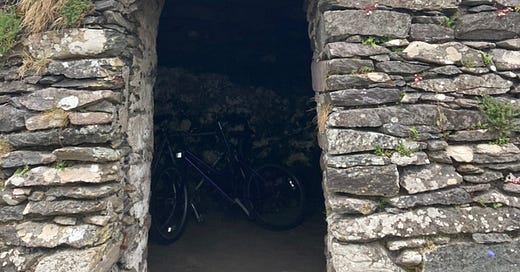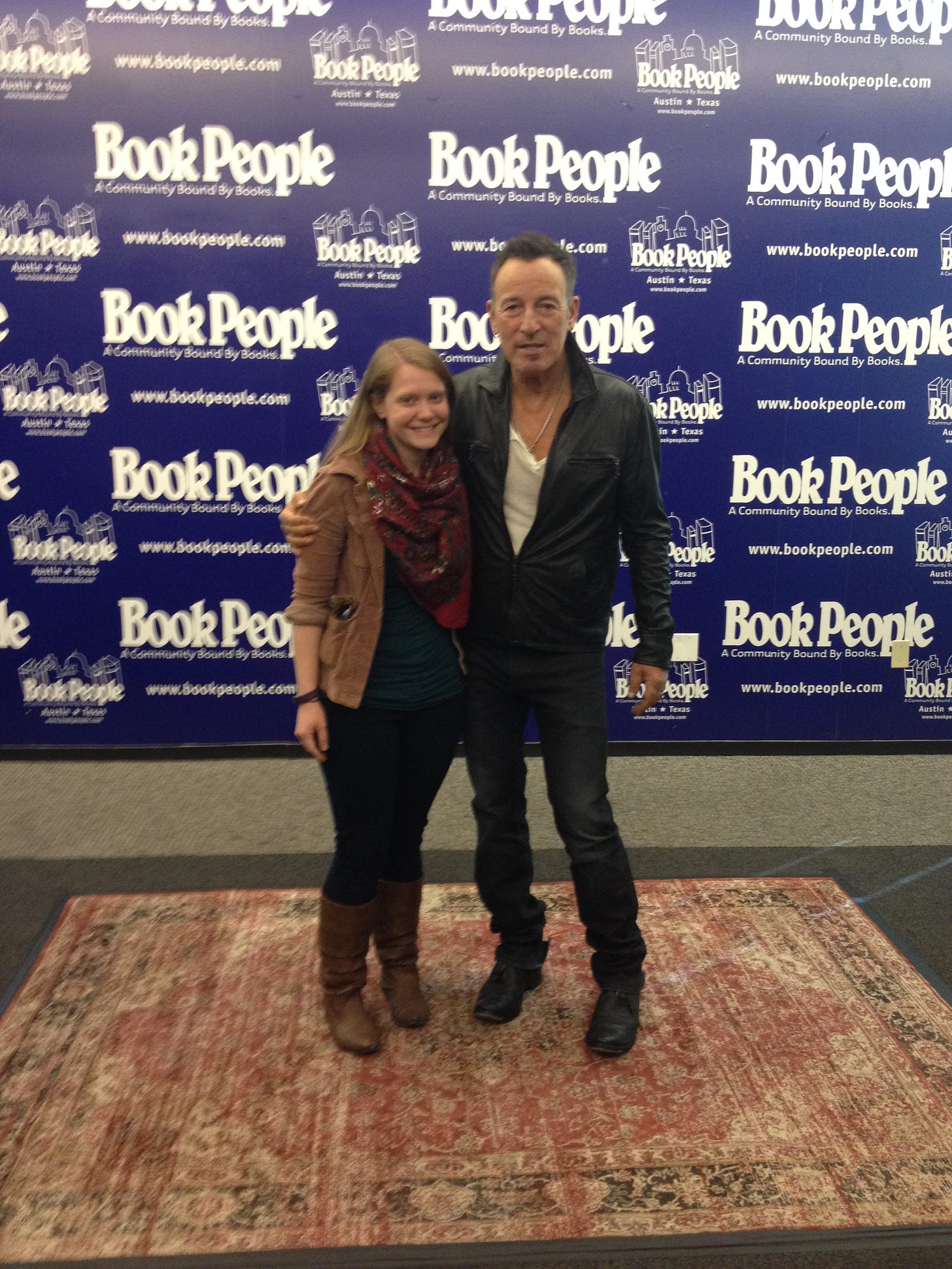As a note to start off: in a single post, I’ve already learned that adhering to all four of the categories I described in the intro newsletter is, if not impossible, impractical (alignment, length, streamlining…all challenging). Thank you for joining me in an experimentation of format!
In my previous career, I was frequently restless because, while my days were flexible, pleasant, and exciting much of the time, I didn’t know what I was doing in my work. I did (and still do) believe that live performance was important. I believed in storytelling, but I didn’t know how I fit into nonprofit theatre. In my first (difficult though they were) months as a classroom teacher, the equation flipped: my days were hard, I didn’t have a clue what I was doing practically-speaking, I didn’t always have the support that I needed, but in the moments when something went right with a student, I knew why I was coming to work every day. I was “cosmically settled” in a way I had never been.
And then I learned what it felt like to have both hard days and to lose your way in terms of purpose. The catchphrase of last year was, “ the human cost of systemic dysfunction.” Public education is not the same as before the pandemic (not like it was easy then, either). Students’ needs are different and more significant, and we are struggling to meet them. Teacher turnover is astronomically high, and salaries are not rising to meet increasing demands and costs of living. There are newer and higher expectations with dwindling support, as well as a changing landscape in terms of vulnerability of teachers’ jobs and reputations at a legislative level. I still believed in doing my job, I believed in my students, I believed in public education; and, a lot of days, simply turning my key in the lock of my classroom door made me shudder.
I had a pit in my stomach the three days before the spring semester started. I had to find ways to counter the feelings of impending doom. I started listening to audiobooks on the way to and from school instead of the news. I took Saturdays fully off (something I’d never been able to figure out how to do previously). I didn’t start working on school stuff before noon on Sundays. I dragged myself out of bed 15 minutes earlier in order to have just a few moments of peace before the day got started.
One of the things that I did during those early morning moments was draw a tarot card. I come from a very logical, stoic worldview; it is not a world where tarot is prominent. Until about two years ago, I equated tarot with Ouiji boards, which, for the record, I find both ridiculous and utterly terrifying (I deftly avoided sleepovers where I thought they might make appearances). For the record: I still don’t really know what Ouiji boards do, but I know they are different from tarot. Tarot cards do not, from my still limited but growing understanding, predict the future. They can function as a way to guide your own intuition about questions, concerns, or curiosities.
The deck I use, The Gentle Tarot, is a beautiful deck designed by indigenous artist Mariza Ryce Aparicio-Tovar (Mari in the Sky) that features animals, plants, and images from Alaska. The artist has replaced many of the “traditional” images (i.e. the page, knight, queen, and king) with seeds, roots, flowers, and harvests, which she explains as “representative of internal stages of growth with a direct connection to nature, and a conscious distancing from colonial symbols.” The images and colors on the cards, as well as the explanations in the accompanying guidebook have felt supportive to me and have also pushed me to think more carefully about my relationship to the natural world.
One of the cards that came up for me often was the Hierophant, which has language around being a student and a teacher simultaneously, as well as a lot of description about ancestors, ancients, and lineage. The artist explains that this card can ask us to think about the question:
“Who has contributed to who you are, both physically in this life and before you arrived?”
This is, of course, a complex question. I have access to quite a bit of information about my family lineage, a privilege not afforded to everyone (more on that in a future post), and I still struggle to wrap my head around lineage in a biological sense. One of the things I like about tarot, particularly this deck, is that it poses questions that don’t necessarily have to be answered in the immediate; there’s time to think “yeah, I have no idea,” then, as the cards emerge again and again, form some kind of response, however slowly, however illogically at first.
My aforementioned stoic midwestern-ism does not like this slow, often anti-linear process. It still doesn’t quite know what to do with the fact that I do a single-card draw most mornings. The rest of my nervous system, however, seemed to experience some benefits. Taking a quiet moment before diving into the WORK of it all to see what emerged and have a question or theme to return to throughout the day helped. It (along with a lot of yoga, a playlist un-ironically titled “Balm for the Soul,” and a healthy dose of compartmentalization) gently reoriented me to my work in a way that made survival to May and even a little bit of optimism about the upcoming fall possible. The question of lineage, of what has gotten us all here stuck with me throughout this summer, too.
I have a very clear memory from graduate school of one of my classmates making a beautiful artistic family tree. I cannot remember if this was an assignment, or something she was completing as part of her thesis research, or if she (likely) just came up with it on her own. She led a small group of us through the process, thinking about the people who had formed us as artists (or, for me, as someone who still does not find the word “artist” one that applies to me, teaching artists and facilitators). We all could write a whole book about who and what has influenced how we work - whether our job is physical or philosophical or a mix of both together, countless people and ideas are part of our lineage, the way we think, the way we move through the world. It’s inarguable that people and ideas who influence us aren’t perfect; in my own lineage, there are elements that make me cringe, but the influence is true, however imperfect. Here are a few of the people, types of media, and ideas (an incredibly incomplete list) who have shifted me in various ways:
My undergraduate dean and department chair, who taught me that good teaching doesn’t have to look just one way;
Aaron Sorkin (perfect though he is not), whose writing still shifts my internal structure.
“The test of a first-rate intelligence is the ability to hold two opposed ideas in mind at the same time and still retain the ability to function.” - F. Scott Fitzgerald;
My middle school principal, whose fiercely caring voice is always in my head when I’m with my own students in tough moments;
My graduate school professors, who were not always there when I thought I needed them but were always there when I actually needed them (which helped me learn the difference);
Alice Hoffman, who writing and approach magical realism first fully captivated my imagination;
Bruce Springsteen and his extraordinary storytelling capacity;
Shakespeare and the people at festivals dedicated to him (complications abounding);
Both the best and worst bosses I’ve ever had for too many reasons to list here;
Mary Chapin Carpenter, whose work encompasses everything about finding home and forward motion all at once;
Robin Wall Kimmerer, whose writing shifted both my thoughts and my actions related to the earth;
A co-facilitator I only met twice but who fundamentally changed the way I engage with my career, my work, and my identity within those things;
Perhaps most importantly, an ever-growing list of teenagers who make me laugh and roll my eyes and marvel at their intuition and that they’ve graced me with a single moment of their attention and trust and who never fail to teach me that I will never, ever know as much as I think I do.
In terms of this newsletter, there’s also lineage. I have gotten Ann Friedman’s newsletter every Friday since 2015. She talks about the simple yet wildly difficult practice of continuing to do a thing that you’re not sure how to do over the course of a long period of time. Reading or listening to a thing over a long period of time is simple and can be wildly difficult, because of…
Time (“When would that happen?”)
Logistics (“Where’s the link again?” and/or “What is the password to my Apple ID and why does my computer need it now?”)
Attention span or novelty-seeking (“How can I possibly put energy toward this thing AGAIN?” and/or “Capitalism makes me feel like I always need new things")
Fear (“I used to agree with this, but last week I didn’t, and I don’t have the capacity to think about changing my mind”).
I’ve let lots of things go over time because of each of these or some combination of them, and also because my interests have genuinely changed, the style of what I’m taking in has changed, or the creators decide to let go of projects to follow their paths in a different direction.
The Ann Friedman Weekly is one of the few media pieces I have an extended relationship with. Some weeks, I open 10 tabs on my computer and spend hours reading recommendations, and some weeks, I read the pie chart (totally worth the yearly subscription fee!) and am done. But I always look forward to it, and I know that engaging with it over nearly a decade has opened my mind to perspectives I wouldn’t have come to on my own. It has broadened the tactics I use to have my students create and reflect on their work. It has reassured me that I’m not alone and not losing it during difficult times. It’s reminded/taught/reminded me again that sometimes we have to take time to be okay, and that people are generally supportive (even if you think they won’t be). It has recommended the many other newsletters that I read and introduced me to writers and thinkers that have become part of my approach, my entertainment, my worldview. Most of all, it has helped me remember that everything comes from somewhere and that sometimes it takes time to see connections between ideas, people, and opportunities. And that reminder, weekly for almost a decade, is worth everything.
Lineage is also incredibly important in yoga, so important, in fact, that I’m going to write a whole other thing about it in a few weeks. In the meantime, if you like, you can pencil in a first date for a yoga class. It’ll be an evening Hatha Flow class, and more information about how to sign up and log in will be forthcoming soon!
This whole post has been largely about input, but I did want to include a list of some additional media that have been part of my lineage, in one way or another.
The Wailin’ Jennys / Violets / Human Stuff / Call Your Girlfriend / Home Cooking / The West Wing Weekly / Ted Lasso / The Sporkful / Yellowcard / Ask Polly / Brené Brown / Mary Oliver / Sarah Smarsh / India Arie / Morgan Harper Nichols
If you’d like to share, I’d love to hear who is part of your integrated work and life lineage!
If someone forwarded you this newsletter and you like it, you can easily subscribe below!









